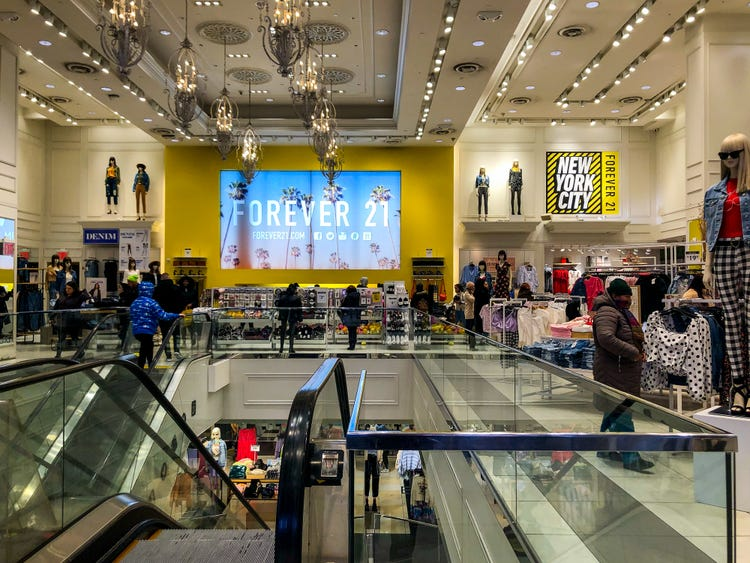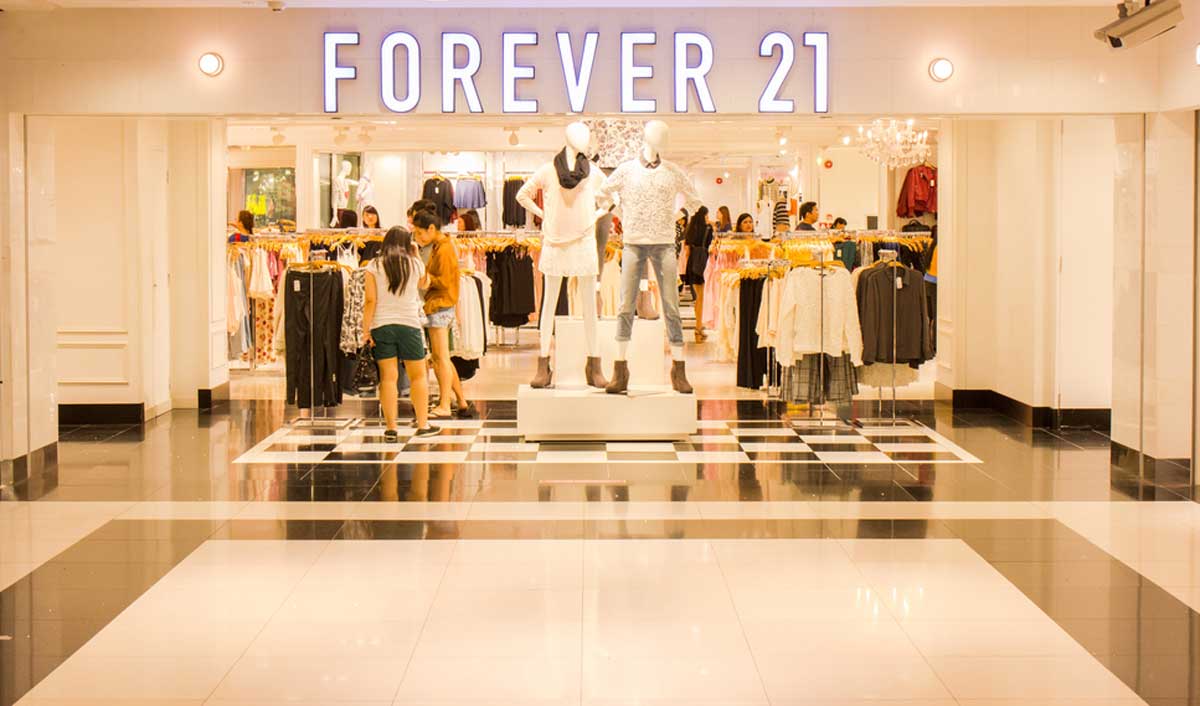A few years ago, Forever 21 was ruling the mall as a spectacular success story, but in 2019, it took a tumble into bankruptcy court, signaling what seemed to be an unhappy ending.
Back in 1984, South Korean immigrants Jin Sook and Do Wan Chang kicked off the chain with a modest $11,000 they had saved from their low-paying service jobs. Their first store, a tiny 900-square-foot space in Northeast Los Angeles, catered to a young crowd, mainly Korean-Americans, offering them cheap and trendy clothing.

The couple had a well-thought-out plan. They adopted a fast-fashion business model, producing quick-turnaround designs that could be mass-produced inexpensively. This approach struck a chord with young customers who desired the latest looks without spending a fortune. By 2015, global sales soared to an impressive $4.4 billion, with a staggering 480 stores occupying vast spaces in malls all over America. Sook and Chang’s wealth skyrocketed, and they amassed a combined net worth of nearly $6 billion.
However, the couple couldn’t have predicted the onset of the “retail apocalypse,” which started in 2017 and posed a threat to nearly every retail chain. Thousands of stores across the U.S. shut down this year, with Coresight Research anticipating a total of 12,000 closures by year’s end, surpassing the 5,844 closures in 2018.
The rapidly changing retail landscape placed immense pressure on Forever 21, eventually leading the privately held company to file for Chapter 11 bankruptcy in late September of 2019. As part of its survival plan, the company revealed it would cease operations in 40 countries, including Canada and Japan, and shut down 350 of its 800 stores, including 178 in the U.S.
The story of Forever 21’s dramatic rise and fall echoes across the retail landscape, yet there are specific factors that contributed to the chain’s troubles. Let’s uncover the top three reasons why Forever 21 struggled to maintain its dominance.
Excessive Stores and Oversized Spaces
Forever 21 experienced a rapid expansion, going from outlets in seven countries to an impressive 47 in just six years. While many other retail chains were downsizing due to the retail apocalypse, Forever 21 was still opening new stores as late as 2016.
One major issue that contributed to the brand’s struggles was their ambitious approach to physical retail space. Forever 21 stores were not only numerous but also quite large, with an average size of 38,000 square feet, and some locations taking up massive spaces, like the Times Square store in New York City spanning 91,000 square feet and a mall store in Las Vegas reaching 127,000 square feet.

The retailer eagerly ventured into costly, large-scale new stores abroad, but without the necessary local expertise. In just a decade, it expanded from having seven international stores in 2005 to a staggering 262. In the filing, Forever 21 revealed that the majority of its international locations were not profitable by 2015. Over the past year, its stores in Canada, Europe, and Asia were collectively facing losses of around $10 million per month. In total, the annual occupancy cost of all Forever 21 stores amounted to $450 million.
This extensive retail space came with a hefty price tag in terms of rent and operational costs. As sales declined by 20% to 25%, the company found it challenging to meet the high demands of premier locations while facing tough competition from fast-fashion giants like Zara and H&M.
Moreover, Forever 21’s large store closures had ripple effects on the malls where they were located. These stores were like anchor tenants, and their shutdowns impacted the overall health of the malls they were in.
Interestingly, while many retailers were shifting towards smaller footprints and embracing digital strategies, Forever 21 was going in the opposite direction with its extensive physical stores. This approach was contrary to the evolving trends in the industry, where retailers were looking to cut costs while still providing accessible brand experiences to consumers.
In the face of retail challenges, other brands were exploring innovative strategies, such as opening smaller pop-up shops and flagship stores to enhance the customer experience. This demonstrated a shift in the retail landscape, with businesses repositioning themselves to survive and adapt to changing consumer behaviors.
Insufficient Emphasis on Online Retail
One of Forever 21’s significant missteps was their lack of focus on bolstering their e-commerce platform, despite their core customer base being young people who prefer shopping online.
In today’s retail landscape, digital presence has become crucial for survival, and most stores rely on it to thrive. For brands targeting younger consumers, digital is the driving force behind their business. Although Forever 21 claimed that 16% of their sales came from online channels, they seemingly missed the mark on realizing the potential of online retail.
Brands like ASOS or Fashion Nova, with their strong online presence, understood the preference of digitally-savvy customers who prefer to shop online, try on the items, and easily return them if needed.
While outdated retail businesses that ignore current trends are facing closures, completely dismissing the value of physical stores might not be entirely accurate. The key lies in paying attention to customers’ changing preferences and desires in this ever-evolving retail landscape.
The Shift to Sustainable Practices
One of the most significant missteps made by Forever 21’s leadership was their failure to recognize a crucial shift in consumer attitudes towards fast fashion. The once successful business model thrived until the world woke up to the urgent realities of climate change.
As awareness of environmental issues grew, the fashion industry faced increasing scrutiny for its significant contribution to global carbon emissions and wastewater. Fast fashion, with its focus on synthetic fabrics and rapid production, shouldered much of the blame for these alarming statistics, as it generated enormous amounts of waste.
The younger generation, in particular, took charge of the sustainability movement, demanding that businesses take responsibility for their environmental impact. Many former fast-fashion enthusiasts, once loyal to stores like Forever 21, abandoned them in favor of clothing that was more durable and eco-friendly, eschewing the throwaway culture associated with fast fashion.
Young consumers are now much more conscious of sustainability issues and willing to invest in higher quality, longer-lasting clothing. The days of frequenting fast-fashion stores multiple times a year are waning, as Gen Zers prioritize brands that align with their values and demonstrate genuine commitment to sustainability.
To survive in this changing landscape, companies like Forever 21 need to integrate sustainability efforts into all aspects of their business, not just in their product offerings. It’s not enough to create sustainable collections; they must also reflect their values in marketing, messaging, and online engagement with customers.
Zara and H&M were commended for rolling out sustainable collections in response to this growing demand, showcasing the industry’s trend towards upcycling, recycling, and clothing rental as part of their commitment to sustainability. For Forever 21 and others, embracing sustainability is no longer an option but a necessity to stay relevant and appealing to the environmentally-conscious consumer base.
Also Read: Driving Trends: H&M Marketing Strategies and Marketing Mix
To read more content like this, subscribe to our newsletter



